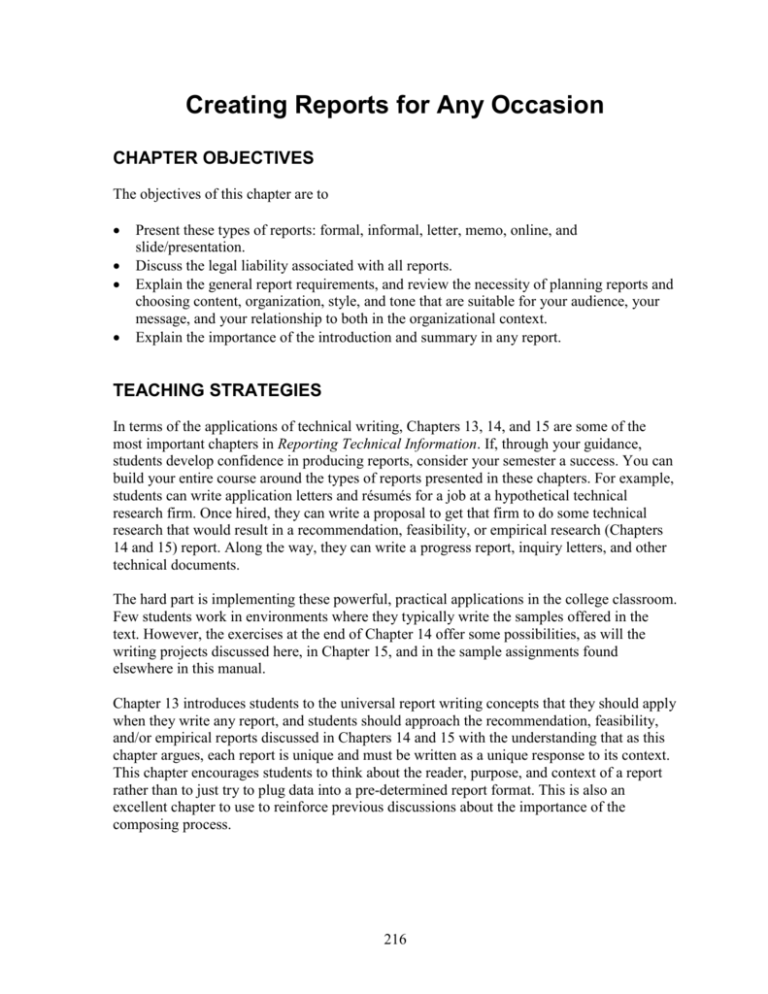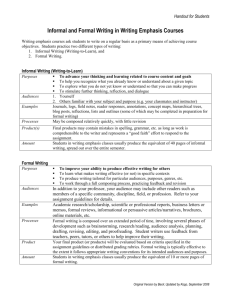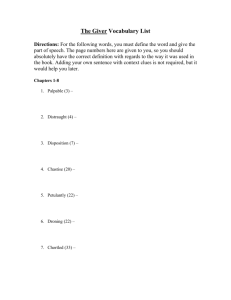Chapter 13
advertisement

Creating Reports for Any Occasion CHAPTER OBJECTIVES The objectives of this chapter are to Present these types of reports: formal, informal, letter, memo, online, and slide/presentation. Discuss the legal liability associated with all reports. Explain the general report requirements, and review the necessity of planning reports and choosing content, organization, style, and tone that are suitable for your audience, your message, and your relationship to both in the organizational context. Explain the importance of the introduction and summary in any report. TEACHING STRATEGIES In terms of the applications of technical writing, Chapters 13, 14, and 15 are some of the most important chapters in Reporting Technical Information. If, through your guidance, students develop confidence in producing reports, consider your semester a success. You can build your entire course around the types of reports presented in these chapters. For example, students can write application letters and résumés for a job at a hypothetical technical research firm. Once hired, they can write a proposal to get that firm to do some technical research that would result in a recommendation, feasibility, or empirical research (Chapters 14 and 15) report. Along the way, they can write a progress report, inquiry letters, and other technical documents. The hard part is implementing these powerful, practical applications in the college classroom. Few students work in environments where they typically write the samples offered in the text. However, the exercises at the end of Chapter 14 offer some possibilities, as will the writing projects discussed here, in Chapter 15, and in the sample assignments found elsewhere in this manual. Chapter 13 introduces students to the universal report writing concepts that they should apply when they write any report, and students should approach the recommendation, feasibility, and/or empirical reports discussed in Chapters 14 and 15 with the understanding that as this chapter argues, each report is unique and must be written as a unique response to its context. This chapter encourages students to think about the reader, purpose, and context of a report rather than to just try to plug data into a pre-determined report format. This is also an excellent chapter to use to reinforce previous discussions about the importance of the composing process. 216 WORKSHOP ACTIVITIES The best way to discuss the issues in Chapter 13 is in conjunction with Chapters 14 and 15, so you may wish to use the workshop activities contained in those chapters rather than try to use a separate set of activities relating just to this chapter. However, if you want to use some activities that deal with reports in a general fashion, here are some ideas. Traditional Classroom 1. Show-and-tell unusual reports. Have students find and bring in unusual reports, that is, reports that are unconventional in some way (typically this will mean in terms of design, organization, or tone). Ask the students to present their reports to the class and discuss what makes them unique and to speculate about why the reports were written as they were. Most students will go to the World Wide Web to locate reports, so you may want to suggest that they search government Web sites (either federal or state) and Web sites of state agencies, such as agriculture extension sites. Many corporate reports, such as stockholder reports, are also available online. You will want need to be broad-minded about the types of reports, audiences, and contexts that students may work with. Don’t limit the students too much or they will become frustrated in their search. If your college or university is a repository for state or federal documents, students will have no difficulty locating hard copy reports if they prefer to go this route. 2. Show-and-tell reports written for a variety of audiences. Ask specific groups of students—either as groups or individually—to locate several reports written for specific types of audiences. For instance, you might ask four or five students to locate reports written for the public, ask another group to locate reports written for engineers, and perhaps have another group locate reports written for farmers/ranchers. Perhaps you would like to have students locate reports that would be written for audiences relating to their future professions. Almost anything will do here: the goal is to have students locate several reports written for a specific type of audience and to compare the approaches the reports use to communicate with their audiences: Are there similarities? Patterns of presentation? Similarities in tone and style? Or is there a wide variety with little similarity? You will want to make sure that the students consider the contexts in which the reports are produced and read; these should have as much impact on the reports as the audiences. Also ask the students to consider how effective the reports are: not every document available online or in print is high quality! 217 Computer Classroom 1. Complete one of the show-and-tell activities above, but use online reports. In addition to the questions discussed above, ask students to consider how the reports are structured for the online environment. 2. Complete textbook Exercise 2. WRITING PROJECTS Rather than assign writing assignments for this chapter per se, you will probably want to assign one of the projects discussed in Chapter 14 or 15 and have your students apply the concepts discussed in Chapter 13 as they create their recommendation, feasibility, or empirical reports. If your students will be creating reports that do not fit neatly into one of these categories, you will want to stress the importance of the concepts in Chapter 13 as students design their unique reports. Students in a distance learning context can also create and submit reports—even lengthy, complex ones—via the Internet, so you can assign the same type of report assignments in this context as you would in a traditional classroom. RELEVANT LINKS The Rauch Center: Analytical Reports (http://www.lehigh.edu/~incbc/resources/writing/analytical.html The Plain English Campaign: The Plain English Guide to Writing Reports (http://www.plainenglish.co.uk/reportguide.html) The University of Toronto, Engineering Communication Centre: Online Handbook (http://www.ecf.utoronto.ca/~writing/handbook.html) University of Surrey, Guildford: Skills Pilot Project Pack: Communications: Report Writing (http://www.surrey.ac.uk/Skills/pack/report.html) Online Technical Writing: Technical Reports (http://www.io.com/~hcexres/tcm1603/acchtml/techreps.html) and Other Types of Technical Reports (http://www.io.com/~hcexres/tcm1603/acchtml/otherep.html) 218 OVERHEADS The figures on the following pages may be reproduced as overhead transparencies or simply shown on a computer. The following set of discussion questions associated with each of the figures may be used to elicit student reflections on the concepts. Discussion Questions for Figure 13-1 Why do you suppose such a variety of reports is necessary? Have you ever written, received, or worked with one of these types of reports? In what context? How did the report function? Discussion Questions for Figure 13-2 Have you ever encountered a report that was obviously poorly planned? What were its weaknesses? What do you think would be the effect if a person, a business, or an organization routinely produced reports without going through the planning process? Discussion Question for Figure 13-3 Examine a sample informal report from the RTI Web site and discuss how it incorporates each of these characteristics. Do these characteristics help you use the report? Discussion Questions for Figure 13-4 Think about the reports you typically write for college. Do their introductions contain any of these elements? How might incorporating some of these in your academic reports improve them? Examine the introductions to some of the sample reports on the RTI Web site, and discuss them in light of these guidelines. 219 Types of Reports Formal Informal Letter and Memo Online Slide Figure 13-1: Types of Reports General Report Requirements Credible reports begin with planning: Understanding the situation that has led to the report Understanding what you want your readers to know after they read the report Understanding their perspective on the information Applying your knowledge of how people read and process information to the development and presentation of the message Choosing content, organization, style, and tone that are suitable for your audience, the message, and your relationship to both in the organizational context Figure 13-2: General Report Requirements Characteristics of a Good Informal Report State the subject early (clear title in subject line) Begin with the main information Keep additional paragraphs short Use design principles to highlight information Tell readers where to get additional information If you plan to e-mail the report as an attachment, include critical information on the first page of the report Figure 13-3: Characteristics of a Good Informal Report The Report Introduction All reports include some type of introduction The introduction must clearly state the report subject, purpose, and plan The introduction may include: The purpose of the report The rationale for the report The scope of the report—what will be covered A summary of the main ideas covered in the main body of the report Perhaps a combination of the summary and an introduction The length of the introduction should depend on the readers’ needs A reader may resist the report; then the introduction must encourage the reader to consider the content Figure 13-4: The Report Introduction





